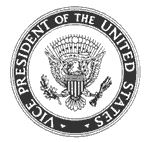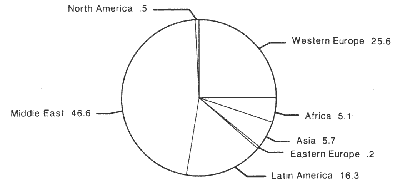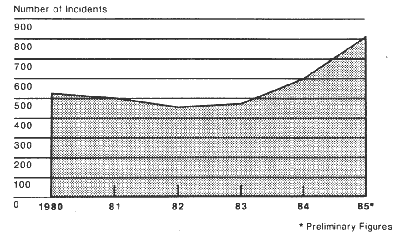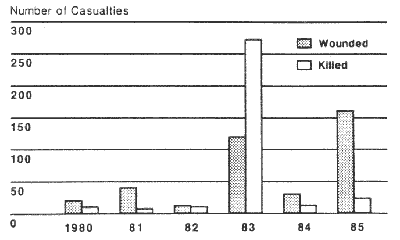Significant 1985 Terrorist
Incidents Involving U.S. Citizens
The Growing Threat of
Terrorism
THE NATURE OF TERRORISM
PROFILE OF A TERRORIST
INTERNATIONAL TERRORISM
DOMESTIC VULNERABILITY
U.S. Policy and Response to
Terrorists
CURRENT POLICY
EVOLUTION OF POLICY
RANGE OF RESPONSES TO
TERRORISM
Managing Terrorist Incidents
Coping with the Threat
Alleviating Causes of
Terrorism
U.S. RESOURCES FOR COMBATTING
TERRORISM
PERSONAL AND PHYSICAL
SECURITY
FEDERAL AGENCIES’ ROLES IN
COMBATTING TERRORISM
INTERNATIONAL COOPERATION
CONSIDERATIONS IN DETERMINING
RESPONSES
INTELLIGENCE
The Role of Congress in
Combatting Terrorism
CURRENT LEGISLATION
PENDING LEGISLATION
POTENTIAL LEGISLATION
Viewpoint of the American
People
Terrorism and the Media
Task Force Conclusions and
Recommendations
NATIONAL POLICY AND PROGRAM
RECOMMENDATIONS
National Programming Document
Policy Criteria for Response
to Terrorists
Establish New National
Security Council Position
Speak with One Voice
Review American Personnel
Requirements in High-Threat Areas
INTERNATIONAL COOPERATION
RECOMMENDATIONS
Pursue Additional
International Agreements
Close Extradition Loopholes
Impose Sanctions Against
Vienna Convention Violators
Evaluate and Strengthen
Airport and Port Security
INTELLIGENCE RECOMMENDATIONS
Establish a Consolidated
Intelligence Center on Terrorism
Increased Collection of Human
Intelligence
Exchange of Intelligence
between Governments
LEGISLATIVE RECOMMENDATIONS
Make Murder of U.S. Citizens
Outside the Country a Federal Crime
Establish the Death Penalty
for Hostage Murders
Form a Joint Committee on
Intelligence
Establish Additional Incentives
for Terrorist Information
Prohibit Mercenary Training
Camps
Stop Terrorist Abuse of the
Freedom of Information Act
Study the Relationship
between Terrorism and the Domestic and International Legal System
Determine if Certain Private
Sector Activities Are Illegal
COMMUNICATIONS
RECOMMENDATIONS
Expand our Current Support
Program for Hostage Families
Launch a Public Education
Effort
Working with the Media
Appendix I VICE PRESIDENT’S
TASK FORCE ON COMBATTING TERRORISM
Appendix II
RESPONSIBILITIES OF PRINCIPAL
DEPARTMENTS AND AGENCIES
Department of Justice
Department of Transportation
Department of Defense
Central Intelligence Agency
Department of the Treasury
Interagency Programs

Fellow Americans:
As 1985 closed, the world was shocked by yet another savage terrorist
act. The violent attacks at the Rome and Vienna airports left 114 wounded and
18 dead, five of whom were Americans. One was a young American girl of eleven.
Earlier in the year we saw the hijackings of TWA Flight 847 and the
cruise ship Achille Lauro, where innocent Americans were brutally murdered by
international outlaws. Such vicious attacks are representative of what has
become a growing trend toward international terrorism over the past decade.
Concerned about the increasing loss of American lives, as well as
repeated terrorist threats against our citizens, last July President Reagan
asked me to chair a Cabinet-level Task Force on Combatting Terrorism.
Comprised of 14 senior government officials with major responsibilities
for our national program to combat terrorism, the Task Force spent the last
half 011985 reviewing and evaluating current U.S. policy and programs.
One of the first things we discovered is that Americans view terrorism
as one of the most serious problems facing our government, ranking it alongside
such issues as the budget deficit and strategic arms control. They want
assurance that the United States is prepared to handle the growing threat of
terrorism, that we have a policy and response mechanism in place, and that we
are working to improve our system. Our citizens’ concern is justified, for
terrorism has grown at an alarming rate. In 1985 alone there were 812
international incidents, with a loss of 926 lives, including 23 Americans.
Clearly the growing threat from increased terrorist activities against
U.S. citizens and interests abroad calls for a strengthening of our own
programs as well as greater cooperation from foreign governments. Domestically,
although there were only seven terrorist incidents in the United States last
year, the potential for future problems exists here at home and we must be well
prepared.
When President Reagan asked our Task Force to review the nation’s
program to combat terrorism, it was not primarily a mandate to correct specific
deficiencies, but one to reassess U.S. priorities and policies, to ensure that
current programs make the best use of available assets, and to determine if our
national program is properly coordinated to achieve the most effective results.
Our Task Force was briefed by more than 25 government agencies, visited
14 operations centers to observe our capability firsthand, met with over 100
statesmen, military officers, scholars and law enforcement officials, and
traveled to embassies and military commands throughout the world where
discussions with both U.S. and foreign officials were conducted.
I personally met with many members of Congress, airline chief executive
officers, media executives, and former Cabinet officials and diplomats.
Our conclusion: the U.S. policy and program to combat terrorism is
tough and resolute. We firmly oppose terrorism in all forms and wherever it
takes place. We are prepared to act in concert with other nations or alone to
prevent or respond to terrorist acts. We will make no concessions to
terrorists. At the same time, we will use every available resource to gain the
safe return of American citizens who are held hostage.
Our national program is well-conceived and working. The United States
currently has in place antiterrorism activities in virtually every federal
department and agency. Specific agencies have been assigned to respond to any
threat or attack directed at our citizens whether on foreign soil, here at
home, in the air or at sea.
To build on these existing safeguards, our Task Force made a number of
recommendations to the President in December 1985. The following public report
on terrorism includes those unclassified proposals dealing with improved
coordination among government agencies, plus the creation of a full-time
position on the National Security Council staff and the establishment of a
consolidated intelligence center on terrorism.
The Task Force also is recommending strong Administration support of
proposed legislation calling for the death penalty against any terrorist who
kills an American hostage. Additional proposals cover increased cooperation
with other governments and outline expanded communications programs with
families of hostage victims, the media and the general public.
While international terrorism poses a complex, dangerous threat for
which there is no quick or easy solution, I believe that the recommendations of
our Task Force will significantly improve America’s capability for combatting
terrorism. As long as vicious attacks continue, terrorism will remain a top
priority of this Administration.

February 2 Greece
A nightclub frequented by U.S. servicemen near Athens is bombed.
Seventy-eight people are injured including 69 Americans.
April 12 Spain
Eighteen people are killed and 37 wounded when a bomb destroys a family
restaurant in a suburb of Madrid. Seven Americans are injured.
June 14 Greece
TWA Flight 847 is skyjacked by Shiite terrorists minutes after takeoff
from Athens. The ordeal lasts 17 days. The 145 passengers include 104
Americans.
A U.S. Navy diver is tortured and shot. His body is thrown out of the
aircraft at Beirut Airport, Lebanon.
June 19 El Salvador
Four U.S. Marines and two American businessmen are gunned down at an
outdoor cafe in San Salvador. A total of 13 people are murdered.
June 23 Over the Atlantic Ocean
An Air-India flight explodes over the Atlantic Ocean, killing everyone
aboard including four Americans.
August 8 West Germany
A powerful car bomb explodes at the U.S. Rhein-Main Air Base near
Frankfurt. The blast kills one U.S. airman and the wife of another. Fifteen
other Americans are injured.
Minutes before the blast, the body of an American soldier is discovered
near Wiesbaden. His identify card had been stolen. Authorities believe the I.D.
was used to gain access for the bomb-laden car at Rhein-Main Air Base.
October 7 The Mediterranean Sea, Near Egypt
The Italian cruise ship Achille
Lauro is hijacked by Palestinian terrorists. A 69-year-old American
tourist is murdered and thrown overboard.
The four terrorists are apprehended when U.S. Navy fighters intercept
the aircraft carrying them to safehaven.
November 23 Greece
Egyptair Flight 648 enroute to Cairo is skyjacked 20 minutes after
takeoff from Athens. One U.S. Air Force civilian employee is murdered and two
other Americans are seriously wounded. A total of 60 persons are killed during
the rescue effort.
November 24 West Germany
A U.S. military shopping mall in Frankfurt is bombed, wounding 32
people including 23 Americans.
December 27 Italy
Rome’s airport is attacked by terrorists armed with grenades and
automatic rifles. Seventy-three people are wounded, 15 are killed, including 5
Americans. One of the Americans is an 11-year-old girl.
Austria
Minutes after the Rome massacre, terrorists strike the Vienna Airport.
Three are killed and 41 wounded. Two of the wounded are Americans.
December 31 Lebanon
At the close of 1985, six American citizens continue to be held
hostage.
1985 U.S. Victims of
International Terrorism
23 Dead
160 Wounded
“We the people of the United States,
in order to form a more perfect union, establish justice, insure domestic
tranquility, provide for the common defense, promote the general welfare, and
secure the blessings of liberty to ourselves and our posterity, do ordain and
establish this Constitution for the United States of America.”
The basic principles of freedom, justice and concern for human life on
which our nation was founded have survived major threats during the course of
America’s history. Today, we face a unique and pervasive challenge to these
ideals in the form of terrorism, an increasingly serious threat to the United
States and its friends and allies around the world.
Terrorism is a phenomenon that is easier to describe than define. It is
the unlawful use or threat of violence against persons or property to further
political or social objectives. It is generally intended to intimidate or
coerce a government, individuals or groups to modify their behavior or
policies.
The terrorist’s methods may include hostage-taking, aircraft piracy or
sabotage, assassination, threats, hoaxes, indiscriminate bombings or shootings.
Yet, most victims of terrorism seldom have a role in either causing or
affecting the terrorist’s grievances.
Some experts see terrorism as the lower end of the warfare spectrum, a
form of low-intensity, unconventional aggression. Others, however, believe that
referring to it as war rather than criminal activity lends dignity to
terrorists and places their acts in the context of accepted international
behavior.
While neither the United States nor the United Nations has adopted
official definitions of terrorism, Americans readily recognize the bombing of
an embassy, political hostage-taking and most hijackings of an aircraft as
terrorist acts. They realize that terrorism needs an audience; that it is
propaganda designed to shock and stun them; that it is behavior that is
uncivilized and lacks respect for human life. They also believe that terrorism
constitutes a growing danger to our system, beliefs and policies worldwide.
The motivations of those who engage in terrorism are many and varied,
with activities spanning industrial societies to underdeveloped regions. Fully
60 percent of the Third World population is under 20 years of age; half are 15
years or less. These population pressures create a volatile mixture of youthful
aspirations that when coupled with economic and political frustrations help
form a large pool of potential terrorists. Many terrorists have a deep belief
in the justice of their cause. They are tough and vicious and may have little
regard for their own lives or those of their victims in attempting to achieve
their goals. Others may even be hired assassins.
Terrorists generally get their weapons from a largely unregulated
international arms market but also resort at times to illegal methods. They
acquire timely information on targets and countermeasures. Lately, they have
resorted to unprecedented violent attacks and, when government security efforts
against them become more effective, they simply shift to easier targets.
While there are several ways to categorize terrorists, for purposes of
this report three main categories are used: self-supported, state-sponsored or
aided, and those individuals who may engage in terrorism for limited tactical
purposes.
Self-supported terrorists primarily rely on their own initiatives, such
as extortion, kidnapping, bank robberies and narcotics trafficking to support
their activities.
Terrorists lacking state sponsorship, aid or safehaven tend to be
extremely security conscious, keeping their numbers small to avoid penetration
efforts.
State-sponsored or aided terrorist groups frequently are larger in
numbers, have the advantage of protection by state agencies and are able to
access state intelligence resources. Because of this host country-provided
safehaven and the compartmented operations of terrorist organizations, it is
extremely difficult to penetrate such groups. Moreover, they are subject to
limited control by their sponsors and may be expected to carry out attacks for
them.
The reasons for state support and use of such groups are many.
Terrorism has become another means of conducting foreign affairs. Such
terrorists are agents whose association the state can easily deny. Use of
terrorism by the country entails few risks, and constitutes strong-arm,
low-budget foreign policy. Growing government assistance in arms, explosives,
communications, travel documents, safehaven and training of fanatics are the
types of aid that state-supported terrorists receive.
Some individuals or groups may choose to engage in terrorist violence
in the context of activities such as national insurgency, especially when they
may be losing a conflict, to try to create a special effect, embarrass opposing
leadership, or change the pace of events.
The most deadly terrorists continue to operate in and from the Middle
East. In 1985 they were involved in roughly 50 percent of the total worldwide
terrorist incidents. The two main sources are militant Shi’ites from various
Middle Eastern countries, especially Lebanon, supported to varying degrees by
Iran or Syria; and radical Palestinian elements, principally offshoots of the
Palestine Liberation Organization (PLO), often with direct support from Libya,
Syria or Iran. Others, such as independent agents of governments like Libya,
also conduct terrorist operations.
Middle East terrorist groups have three main targets: Israel; Western
governments and citizens, particularly the United States, France, Italy, and
the United Kingdom; and moderate Arab governments and officials, particularly
those of Jordan, Egypt, Kuwait and Saudi Arabia.
Many terrorist organizations have continued to operate in Europe during
the past decade, including the Italian Red Brigade, French Direct Action,
German Red Army Faction and the Provisional Irish Republican Army. The latter
has been and remains the most active.
Geographic Distribution of
International Terrorist Incidents

Established leftist groups in Spain, Portugal and Greece continue their
terrorist campaigns, while a new group has surfaced in Belgium, a country
hitherto relatively free from terrorism. Recently, there have been disturbing
indications that leftwing terrorists of several nationalities are beginning to
cooperate and coordinate their attacks. Of the 812 incidents worldwide in 1985,
over 200 took place in Western Europe.
In Latin America, social, economic and political turmoil have prolonged
existing patterns of insurgency as well as international and domestic terrorism
in several countries, particularly El Salvador, Colombia, Guatemala, Chile and
Peru. Nicaragua and Cuba also have been implicated in terrorist activity in the
region. During 1985 there were more terrorist incidents (86) directed at U.S. citizens
in Latin America than anywhere else.
Certain governments have demonstrated a growing propensity to use,
support and exploit terrorism as an instrument of national policy. This trend
toward the alignment of interests between certain states and terrorist groups
has markedly elevated threat levels worldwide, as state and financial resources
have expanded terrorists’ capabilities.
Terrorism is as old as recorded history, but the past two decades have
witnessed a dramatic increase in international terrorist acts by people and by
governments in the pursuit of their goals. The past year saw the number of
terrorist incidents reach a high of 812.
International Terrorist Incidents
1980- 1985

Half of the worldwide incidents in the 1980s were aimed at only 10
countries; one-third of the total were targeted directly at the United States.
The number of terrorist acts has generally risen since official statistics were
first compiled in 1968, with a trend toward bloodier incidents with more
fatalities. Attacks caused 20 fatalities in 1968 compared to 926 in 1985.
Incidents in 1985 demonstrated that terrorism is increasingly directed
against the Western democracies. The June 14, 1985, hijacking of TWA Flight 847
shortly after it left Athens was the first hijacking of a U.S. airliner in the
Middle East since 1970. In addition, the hijackings of Egyptair Flight 648 and
the Achille Lauro, the bombing of
a restaurant on the outskirts of Madrid frequented by American servicemen and
the shooting of the off-duty Marine Corps personnel in El Salvador demonstrate
that Americans are being specifically targeted. The year ended with the brutal
attacks in the Vienna and Rome airports where five Americans were murdered.
During the past decade, terrorists have attacked U.S. officials or
installations abroad approximately once every 17 days. In the past 17 years,
terrorists have killed as many U.S. diplomats as were killed in the previous
180 years.
U.S. Casualties Resulting From
International Terrorist Incidents
1980-1985

In 1982, a total of 57 attacks were directed against U.S. military
personnel, resulting in two deaths. In 1983, even more incidents occurred (65),
and 241 deaths resulted from one incident. In that bombing of the U.S. Marine
barracks in Beirut, the United States lost nearly as many servicemen as the
British lost in the entire Falklands campaign.
While the number of terrorist acts outside our borders increased
dramatically in the last three years, incidents within the United States have
declined from 51 acts in 1982 to only seven in 1985. And while 23 Americans
overseas lost their lives to terrorists last year, only two citizens were
killed within our own borders. This can be attributed in part to the success of
the Department of Justice and Federal Bureau of Investigation (FBI) in their
counterterrorist activities. Additionally, it appears that international
terrorist groups find it easier and safer to target Americans overseas rather
than within the United States. In 1985, there were 23 terrorist incidents
prevented in the United States by the timely action of the FBI and other law
enforcement agencies.
FBI efforts in 1985 included the foiling of a plot to assassinate Prime
Minister Rajiv Ghandi of India while visiting the United States; the uncovering
of a pro-Qaddafi conspiracy to carry out three assassinations and to bomb
strategic locations in the United States; the interdiction of a Sikh assassination
plot in New Orleans; and the prevention of planned bombings in India by the
same group.
Terrorist Incidents in the United States
1980-1985
|
Date
|
Total Incidents
|
Killed
|
Injured
|
|
1980
|
29
|
1
|
19
|
|
1981
|
42
|
1
|
4
|
|
1982
|
51
|
7
|
26
|
|
1983
|
31
|
6
|
4
|
|
1984
|
13
|
0
|
0
|
|
1985
|
7
|
2
|
10
|
Over the years the FBI has become increasingly involved in “special
events” of national and international interest that take place in the United
States and which could serve as an attractive target against terrorism. The Pan
American games in San Juan, Puerto Rico, were the first such event where the
FBI took precautions against terrorism. Others have been the New Orleans
World’s Fair and the two 1984 national political conventions in San Francisco
and Dallas.
The 1984 Olympic Games in Los Angeles, with a record 140 countries
participating, received close scrutiny by the FBI and other federal agencies.
The federal law enforcement community worked in conjunction with local and
state officials to coordinate the flow of intelligence regarding possible
terrorist movements and attacks. Contingency plans were developed for an
emergency response to any incident that might have occurred.
Despite this outstanding track record in combatting terrorism
internally, our vulnerability remains. In fact, while the losses from terrorist
attacks are minimal compared to the 40,000 highway deaths or 18,000 murders
that occur annually in this country, there is more at risk
than the senseless loss of lives.
Terrorism is political theater designed to undermine or alter
governmental authority or behavior. The apparent inability of established
governments to respond effectively to incidents affects the confidence of
citizens and allies alike. America’s foes take comfort in the apparent
weaknesses of our society that terrorism exposes.
Our vulnerability lies, ironically, in the strength of our open society
and highly sophisticated infrastructure. Transportation, energy,
communications, finance, industry, medicine, defense, diplomacy and government
itself rely on intricate interrelated networks. Given these inherent
vulnerabilities, and the fact that Americans are increasingly the targets of
terrorist attacks outside the United States, it is apparent that a potentially
serious domestic threat exists. Recent threats such as Qaddafi’s statement that
Libyans will attack “American citizens in their own streets” only serve to
underscore this worsening climate.






